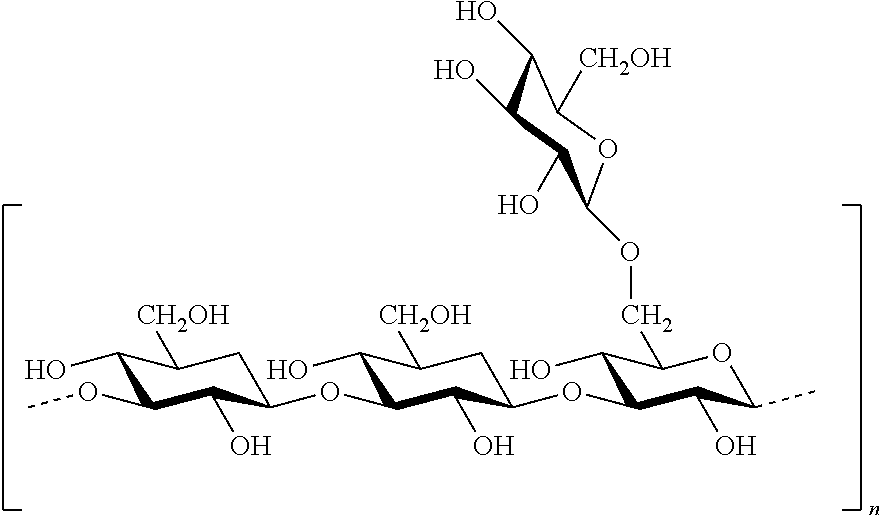Use of a (1>3)-β-D-glucan as an emulsion stabiliser
a technology of emulsion stabilisation and dglucan, which is applied in the direction of medical preparations, building components, chemical/physical processes, etc., can solve the problems of poor breaking properties, emulsions may start to destabilise, and emulsions tend to “break” or separa
- Summary
- Abstract
- Description
- Claims
- Application Information
AI Technical Summary
Problems solved by technology
Method used
Image
Examples
example 1
[0086]A scleroglucan (Actigum® CS 6 purchased from IMCD, the Netherlands) mixture with a food grade vegetable oil (purchased from Mosselman N. V., Belgium, or Heybroek B. V., the Netherlands) was prepared by mixing the two components at room temperature in a weight ratio of 1:2. The food grade vegetable oil is protecting the scleroglucan particles to conglomerate in an aqueous medium and hence a homogenous dispersion is obtained when this mixture is added to water whilst stirring.
[0087]Emulsions were produced according the following procedure. To 99.232 units of weight of water at a temperature of about 60° C., 0.428 units of weight of a 30% hydrochloric acid solution was added whilst gently stirring. After the addition of 0.24 units of weight of Redicote® E9 fatty amine emulsifier (purchased from Akzo Nobel) to the water, 0.1 units of weight of the scleroglucan-food grade oil (1:2) mixture was added. Both the water and a soft bitumen, i.e. Exxon Mobile bitumen with a penetration ra...
example 2
[0090]Aqueous solutions of scleroglucan were prepared by dissolution of the polymer at 50° C. The amounts of the scleroglucan (Actigum® CS 6 purchased from IMCD, The Netherlands)-food grade oil mixture added was varied from 0 to 1 units of weight. The aqueous solution had a pH of 1.9. The solutions were stored at 50° C. for 7 days and subsequently at 60° C. for 5 days. This resulted in a negligibly small viscosity decrease. The viscosity data (cP) were determined using a Brookfield Reometer type DV-11+ equipped with a spindle type 2, and the results are summarised in Table 2.
[0091]From the viscosity data shown in Table 2 it appeared that the solutions were stable for at least 12 days when stored at a temperature of 50° C. or even higher.
[0092]Similar experiments were performed with other polysaccharides, e.g. starch and cellulose, including Natrosol® Plus 331 and 430 (data sheet 23.103-E5) of Hercules, and derivatives of these polysaccharides, but for all these materials the viscosi...
example 3
[0098]Bitumen emulsions were produced according to the procedure as described in Example 1, but with different Actigum® CS 6-food grade oil (1:2) mixtures ranging from 0.0 to 0.2 wt. % (0.0-0.067 wt % of scleroglucan). These mixtures contained about 83 wt. % of pure Actigum® CS 6, based on the total weight of the mixture, wherein the remainder is moisture. Hence, a value of 0.05% (cf. e.g. Table 4) corresponds to an amount of about 0.0042 wt. % pure Actigum® CS 6. These corrected values are shown in brackets.
[0099]
TABLE 4Methodof0.05%0.07%0.09%0.1%0.2%analysis0%(0.0042%)(0.0058%)(0.0075%)(0.0083%)(0.0166%)Water content %EN 142842.141.942.041.642.342.6Efflux timeNEN232830322833(25° C. in sec.)3947pHEN 128502.32.42.42.42.32.3Breaking indexNEN-EN868987888787(20° C.)13075-1
[0100]Only a slight increase in the viscosity is observed at increasing Actigum® CS 6 content. Note that the Actigum® CS 6 added is only one third of the Actigum® CS 6-food grade oil (1:2) mixture.
[0101]All these samp...
PUM
| Property | Measurement | Unit |
|---|---|---|
| wt % | aaaaa | aaaaa |
| temperatures | aaaaa | aaaaa |
| wt. % | aaaaa | aaaaa |
Abstract
Description
Claims
Application Information
 Login to view more
Login to view more - R&D Engineer
- R&D Manager
- IP Professional
- Industry Leading Data Capabilities
- Powerful AI technology
- Patent DNA Extraction
Browse by: Latest US Patents, China's latest patents, Technical Efficacy Thesaurus, Application Domain, Technology Topic.
© 2024 PatSnap. All rights reserved.Legal|Privacy policy|Modern Slavery Act Transparency Statement|Sitemap

